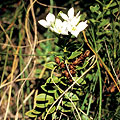 |
|
|
|
|
|
|
The highest mountains of New Zealand are found in the N-S cordillera of the South Island, the so-called New Zealand Alps, with Mt. Cook reaching 3754 m. The western flanks are very wet, receiving several meters of rainfall per year in the south. The E-flanks are drier, but there is no drought at alpine elevations. Very attractive alpine vegetation is also found in the Old Man and Rock and Pillar Ranges of Otago. The treeline is formed by Nothofagus sp. at 1200 m elevation. |
|
1 - Rock and Pillar Range, Otago, snow tussock landscape at c. 1300 m, near the potential treeline. |
|
|
2 - Shrubs of Hebe poppelwellii (Scrophulariaceae) at 1300 m in the Rock and Pillar Range - one of the many Hebe species. |
3 - Aciphylla hektori (Apiaceae) - male and female inflorescence. Aciphylla is a genus with many species in New Zealand. |
4 - Lobelia linnaeoides (Campanulaceae). Compare the giant rosettes in the marshes of central Africa and a similarly small species of this genus in Venezuela. |
|
5 - A Raoulia sp. (Asteraceae) cushion (Old Man Range, 1640 m). When in full bloom, this cushion looks like a sleeping sheep. |
6 - Raoulia hectori (Asteracae), Phyllachne colensoi (Stylidiaceae) and Dracophyllum sp. (Ericaceae) jointly forming dense cushions (Old Man Range, 1500 m). |
|
7 - Snow tussock grasses (one of the three Chionochloa (Poaceae) species) at 1550 m on Mt. Brewster. Note the similar appearance of Carex curvula (Cyperaceae) in the Alps. |
|
|
8 - Gentiana montana (Gentianaceae) (Mt. Brewster, 1200 m) |
9 - Hebe macranta (Scrophulariaceae) (Mt. Brewster, 1400 m) |
10 - Hebe hektori (Scrophulariaceae) (Mt. Brewster, 1500 m) |
11 - Leucogenes grandiceps (Asteraceae), the New Zealand edelweiss (Mt. Brewster, 1500 m). |
|
12 - Pernettya alpina (Ericaceae) (Mt. Brewster, 1700 m) |
13 - Ranunculus sericophyllus (Ranunculaceae) (Mt. Brewster, 1700 m). |
14 - Mt. Brewster (2423 m) |
29 August 2011 |
||
| |
||















